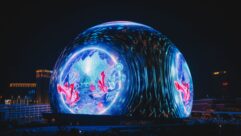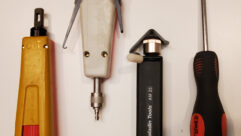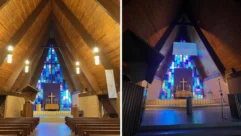Getting the LED Out
Feb 1, 2002 12:00 PM,
By Peter H. Putman, CTS
SEVERAL MONTHS BACK, I wrote about the horse race among display technologies, inspired by spending several days at CEDIA Expo 2001 and carefully analyzing price trends and technology. I concluded that DLP and plasma were ahead of the pack for consumer direct-view and rear-projection televisions, particularly where there was a need for high-definition display. I even predicted that DLP and plasma would eventually duke it out as screen sizes and pricing leveled out. The same sort of evolution is happening in the market for super-sized, high-brightness displays.
A decade ago, this meant stacking CRT projection cubes or using emissive displays like Mitsubishi’s Diamond Vision and Sony’s Jumbotron. But today, the humble light-emitting diode is emerging as the favored player in this category. LED is carving its own niche in the stadium/arena and public display markets, particularly where a scalable, very bright display is required to work under ambient light levels up to 40,000 lux or, in other words, broad daylight.
LITTLE RED BUMPS?
what makes the led such a dominant display engine? After all, LEDs have relatively large diameters that create pixel structures too coarse for close-up viewing. And that’s exactly why they excel in displays where the viewing distances are long to extreme, such as in a football stadium, colleseum or on a billboard. At these distances, coarse rows of pixels become smoothly blended images with bright, saturated colors. And, let’s face it, what other choices are there under such harsh lighting conditions?
One of the big advantages that LED displays have over other technologies is modularity. Individual LEDs are attached with epoxy into pixel arrays that resemble playing dice, with extra LEDs allocated for blue and green. One common LED matrix uses five LEDs arranged like the number 5 on a die, with the blue LED in the center plus two reds and two greens at opposite ends. Another arrangement is to put eight LEDs in a box with three green, three red and two blue elements (see Figure 1).
Each array of LEDs makes up a pixel, and LED “modules” can contain as few as 10 such pixels. Typically, an LED module will have very many more columns and rows than this. Increasing the size of the array means tiling these panels together, along with individual addressing and power cabling. Like a plasma panel, LED displays only grow in height and width, not depth.
While there are lots of LEDs in a given module, the actual display resolution is not very high, usually from half-VGA (320 by 480) or smaller, to SVGA (800 by 600). Also, LED pixels vary in pitch, with smaller pitch arrays used for smaller screens. Typical pitches range from 4 to 30 mm, with brightness ratings in the 2000-nits range for smaller arrays and over 5000 nits for larger arrays.
You can see that LED display technology is scalable in a number of ways. It’s closest relative in the display world — the plasma display panel — also combines bright images and an RGB pixel matrix in a direct-view display, but you’d never get 2000 nits out of a 50-inch PDP (it would probably burst into flames long before that). And the pixels in a plasma panel are not scalable, although plasma monitors can be — and are — tiled in the same way as video projection cubes. The apparent resolution of an LED wall has everything to do with viewing distance. A typical pixel pitch for 50-inch plasma would be around 1 mm, so you’d have to stand 10 times as far back from an LED wall with a 10mm dot pitch. If the optimum viewing distance for the PDP works out to 75 inches, about 6 feet (that’s about 1.5 times the screen’s diagonal dimension), then you’d want to be at least 60 feet from a 10mm-dot-pitch LED wall for the pixels to appear the same relative size.
Perhaps the biggest advantage of LED displays is that they are low-voltage devices. An LED can fire with just a few volts potential from anode to cathode, and once the LED fires, its brightness is variable with an increase in voltage. LEDs can also be overdriven and burn out (or even burn up, as did a prominent LED sign in Times Square a few years back).
LED IN TODAY’S MARKET
like plasma and dlp, led displays are starting to collide with other large-venue electronic displays. Front projectors can’t always hack the high ambient lighting environment of a stadium or arena, unless the screens are shaded to reduce light leakage or a decision is made to let black levels fall where they may. But tiled LED displays are also starting to push high-brightness projectors off musical stages, where flying a screen and a projector or two becomes much more of a labor and maintenance headache than it would be to simply hoist a self-contained LED screen.
The one thing LED displays can’t do is replace a contiguous curved screen. That’s still the domain of high-brightness front or rear projectors. But for everything else, the tiny LED has proven itself to be a formidable imaging engine. It doesn’t weigh very much, either — just under 20 pounds per square foot installed on average. LED panels can be assembled in some really clever ways, too. A recent VH-1 awards show had the recipients walking though a hinged LED panel, just like a barroom door.
There are several companies selling and integrating LED modules in a variety of sizes, including Smartvision, Barco, Lighthouse Technologies and Electrosonic. Each offers a wide range of LED panels in various pitches for everything from public display to super-wide stadium screens. As you look through their specifications, you won’t see a tremendous difference in products — LEDs are LEDs, after all — other than the fact that the outdoor modules have coarser pixel pitch and develop a tremendous amount of light (these have extra LEDs in each pixel.)
Smartvision has been active in the replacement of old Jumbotron and similar displays in outdoor and indoor stadiums around the country. Miller Field, home of the Milwaukee Brewers baseball team, opened this year and features a 27×48-foot Smartvision LED screen. This screen has an effective pixel resolution of 270 × 484 and is used to show player stats and live action. (For more, see Gregory A. DeTogne’s profile on Miller Park in S&VC‘s November 2001 issue or at svconline.com.)
These LED modules have a 30mm pitch with a 4-red/3-green/3-blue matrix; the wall provides over 130,000 imaging pixels from a total of more than 650,000 individual LEDs. Smartvision rates the screen brightness at 6000 cd/m2 (nits) when calibrated to D6500 color temperature. Specialized circuitry adjusts the brightness to compensate for the changes in ambient light during daytime operation.
Ten-bit signal processing is used exclusively. Even though the image resolution is about half-VGA, outboard processors can scale anything from video to SVGA computer sources to fit. Additional processing allows effects such as multiple video windows, zooming of images, picture-in-picture and graphics overlaid on or mixed with live video; in short, they are the same effects you’d expect from a video switcher.
Barco DLite and ILite LED panels are making their way into the National Football League. The NFL’s newest team, the Houston Texans, will pack LED screens into their new stadium for its big opening in the fall of 2002. The centerpiece will be a pair of 27×96-foot screens using 14mm-pitch LEDs in a 576×2080 pixel array, for a total of 1,198,080 pixels. The wall brightness has been specified at 5000 nits.
Images will originate from an HDTV-capable production studio, feeding signals as SD-SDI at first and then moving to HD-SDI with 10-bit signal processing. Sources will include Digital Betacam, HDCAM and servers. All image processing and scaling will be performed in a Barco D320 digitizer, which allows the display of multiple full-resolution HD 16:9 images and includes advanced effects such as picture-in-picture, windowing, digital effects and z-ordering of multiple images of various formats and resolutions.
DLite LED modules are available in four different pitches: 14, 19 and two 28mm versions. Individual modules measure about 17.5 inches square with a depth of 7.5 inches and a weight of 31 pounds each. Each module is rated at 5000 nits brightness, much too bright for most close-up and personal public display options. The 2000-nit ILite product is a better choice here, and it comes in 6, 8 and 10mm pitches. Each module measures 17.5 inches square and a little under 6 inches deep.
Lighthouse has been quite active with large-venue staging projects. The recent U.S. tour of the Dave Matthews Band made extensive use of 96 LVP20 serial digital 20mm LED panels owned by California-based video production company BCC Video/Screenworks. The LED panels were originally configured as two 8×6 panel screens, situated on either side of the stage; however, lighting designer and video director, Fenton Williams, later redesigned the set to have two 6×4 panel side screens and added a pair of 5×3 panels upstage, behind the band. Two more 3×3 screens were positioned out wide.
According to BCC Video/Screenworks’ Danny O’Bryen, “This is the fourth year we’ve done Dave Matthews in stadiums, but it’s the first year we’ve used Lighthouse, and everybody’s very happy with it. The 20mm outdoor modules have great resolution and color.” Apparently, the Lighthouse panels can take quite a beating, too. “Just a week before going out on the DMB tour, [the panels] had been smashed continually against scaffolding by 105mph winds at an outdoor event,” noted O’Bryen. “I was amazed at how little damage they suffered. It proved that they are pretty much indestructible.”
Lighthouse’s new LVP-102 seamless panel measures 25.2 by 19 inches and is 4 inches thick. It features 10mm-dot-pitch LEDs and tips the scales at 46 pounds. The LVP-102 can develop 1000 nits and employs 10-bit signal processing for improved video rendering.
Electrosonic is another recent entrant into the LED display market. It currently offers Lightscape, a range of LED panels in a variety of pixel pitches. These panels have a finer pitch suitable for closer viewing, and come in 6, 8 and 10mm ranges. Each panel measures about 17.6 inches square with a depth of 5. 8 inches and a weight of 25.4 pounds. Brightness is rated at 2000 nits, and sources from interlaced video to HDTV and computer graphics to SXGA are supported by Electrosonic’s Vector processor.
Peter H. Putman owns PHP Communications, Doylestown, Pennsylvania. He has been reviewing display technology for years and is known for his journalistic coverage of InfoComm and tech trade shows, his experiments with home-made DTV antennas and his authorship of The Toastmasters Guide to Audio/Visual Presentations.
Switching in LED Arrays
LEDs can be switched in two ways. The first is to simply vary the brightness of the LED in response to an analog change in driving voltages. That’s fine for a static image, but it uses a lot of power. The second and more practical way (especially to show video) would be to use pulse-width modulation and rapidly switch the LEDs on and off, using the ratio of on-cycles to off-cycles in a given time interval to generate a grayscale.
LEDs have very high switching speeds and can easily follow a 30 or 60Hz rate required by video. In fact, they can be refreshed several times faster — from 300 to 400 Hz if need be — to eliminate picture flicker and allow the display of rapid motion. That’s why LEDs have proven so popular in stadium installs. Most spectators sit sufficiently far from the screen so the pixel structure isn’t evident, and video looks fine.
The high refresh rate also allows for a wide color palette. Currently, the industry seems to be hovering around a 1.07 billion color palette, which is defined as 1024 colors per channel (or 1024 shades each of red, green and blue). This 10-bit color palette far exceeds that of any RGB imaging device, with the exception of specialized electronic cinema projectors. And the displayable color gamut takes in a much bigger space than NTSC or HDTV.
It has been proven that 8-bit sampling won’t cut the mustard with video, particularly with dark scenes. Dynamic false contouring or abrupt changes in brightness levels in the low grays occur. Readers who work with plasma panels know this effect all too well, as it is the bane of home theater installers. By adding two extra bits per color channel, those same low levels can be sampled more smoothly.









